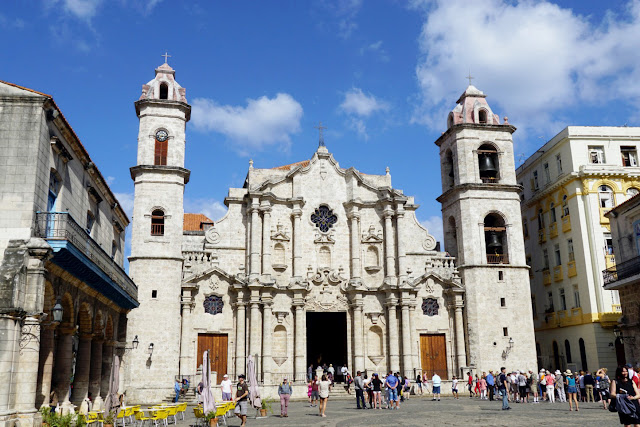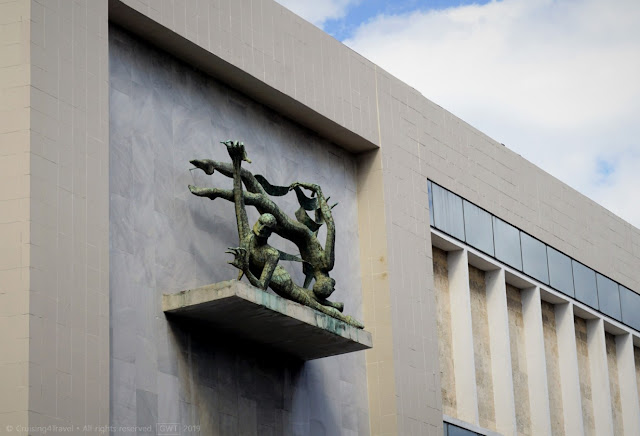For our first port of call we found ourselves back in Havana, Cuba, not 48 hours after we'd left our MSC cruise. Not knowing about the change in our itinerary ahead of time, we didn't have to chance to find a tour guide for our day here.
We waited a bit to leave the ship, letting the first crush of people go, so by the time we went through immigration, there were no line-ups at all. We had a map from the ship to guide us, and some warm sunny weather for our day ahead. We started out wandering along the streets, with a plan to spend the first part of the day seeing more of the sites we touched on during our first visit. Then after lunch , we headed out to the Almacenes San José Artisans' Market for some souvenir shopping, and then the Castillo de la Real Fuerza for a bit more history.
This was our 3rd day visiting Havana in 4 days of cruising. For our first 2 days in Havana which feature many more sights of the city, look here: Caribbean-Cuba - MSC (Day 6) and Caribbean-Cuba - MSC (Day 7). This post about our 3rd day in Havana is a more casual visit to the city.

Just off Plaza de Armas, we walked down Calle Obispo with it's beautifully restored buildings.

This group of performers enlivened the pedestrian street as we strolled.

This "statue" is a busker skillfully dressed as a bronze statue. This was one of the best examples of this kind of street performer I've ever seen.

We found ourselves back in the Plaza de la Catedral, but in daylight this time. The Havana Cathedral (Catedral de San Cristobal) was open for visitors, so we stepped inside.

"The cathedral was renovated between 1946 and 1949 in the neoclassical style. Cuban architect Cristobal Martinez Marquez headed the project and through a series of architectural procedures gave the church interior a more open and grandiose space, allowed more light to enter, and improved its ventilation system."

Another view of the inside of the cathedral.
For a small fee, we gained access to one of the bell towers.

"One can see fossilized marine fauna and flora in the stone walls as the Cathedral is, as many buildings in Havana are, constructed out of blocks of coral."

Looking down into the Plaza de la Catedral from high up the bell tower.

The top of the bell tower gave us a great view of Havana's skyline.
Just off the Plaza de la Catedral we came across the famous La Bodeguita del Medio. The crowd outside was even bigger during the day than it was a couple of nights earlier.

Inside Bodeguita it wasn't nearly as crowded as the evening, and no band playing this time. It sure is a small place, and clearly remains high on the list of "must do" for a visit to Havana.

An interior courtyard in a building next to La Bodeguita del Medio.

We continued our walk through the old streets of Havana.

This was a little more off the beaten track for tourists - more of a local's area of town, and not a street we had visited with our guide. (So I really don't know just where we were when I took this picture.)

Passing a neighbourhood market.
Not all of the buildings we passed were old. This more modern building featured a nice touch of sculpture.

"The Bacardi Building built in 1930 was designed to be the headquarters for the Bacardi Rum Company; it was nationalized by the Castro government in the early 1960s. In 2001, the building was restored by an Italian construction firm. The interior retains the original decorations in marble and granite. It is regarded as one of the finest Art Deco buildings in Latin America." The lobby was very nice, but that's about all we saw of the interior.

"The Gran Teatro de La Habana (the former Centro Gallego). Located in the Paseo del Prado, the theatre has been home to the Cuban National Ballet and to the International Ballet Festival of Havana. Its facilities include theatres, a concert hall, conference rooms, a video screening room, as well as an art gallery, a choral center, with several rehearsal halls for dance companies."

"El Floridita is an historic fish restaurant and cocktail bar. The establishment is famous for its daiquiris and for having been one of the favourite hangouts of Ernest Hemingway in Havana." With the many old cars on the street, it really looked like we'd stepped back in time.

This classic car with it's iridescent paint job was one of the coolest paint jobs we came across. The dog is completely unimpressed.

Pink seemed to be a popular colour this day.

More pink and red cars, with an even more classic mode of transportation rolling by. (At least the horse and buggy had a passenger - the cars were waiting to be hired.)

Yep - definitely a pink car day. This group was parked outside "Hotel Inglaterra - the oldest hotel in Cuba and one of the most classic hotels in Havana." The current building opened in 1875. Over the years, successive owners have added floors and modernized the hotel.

This car stood out because it wasn't pink or red.

We got a close up view of this beautifully maintained red convertible. A friendly local started talking to us, and offered to show us around the neighbourhood a bit.

Behind the metal fencing, this old building looked like it was abandoned after restoration had begun.

A popular market for "locals only" we were told.

Some of the fruits and vegetables on sale.

We ended our "tour" at a bar, where we all had the bar's version of a mojito, with a splash of red wine on top. They were very expensive (for Cuba). We expect there is a different price for locals. The small bar was (we were told) home to "Compay Segundo, so called because he was always second voice in his musical partnerships. In the 1950s he became well known as half of Los Compadres, and gained greater international fame in 1997 with the release of the Buena Vista Social Club album."

"The Our Lady of Kazan Orthodox Cathedral, a Russian Orthodox cathedral located in historic old town Havana." Consecrated in 2008, it's by far the youngest church we saw.

Along our walk to the Almacenes de San José market.

Stepping into the vast warehouse. "This harbourside warehouse was built in 1885 and is considered the oldest depository in Old Havana. The sober and imposing façade that looks out onto the city conceals the building’s steel structure, which has endured the passing of time and is perfectly preserved."

Hundreds (or seemingly hundreds) of artisan kiosks. Row upon row of sellers hoping for your tourist dollar. It was overwhelming to walk through the long aisles with each vendor trying to attract your attention and dollar.
A sculpture and some cannons outside "The Castillo de la Real Fuerza, a bastion fort on the western side of the harbour, set back from the entrance, and bordering the Plaza de Armas. Originally built to defend against attack by pirates, it suffered from a poor location; it is too far inside the bay."

Inside the fort, looking across the moat and drawbridge.

Some of the original cannonballs and pottery found inside the fort.
A 4-meter Replica of "Santísima Trinidad, a Spanish first-rate ship with 112 guns. This was increased in 1795–96 to 130 guns and around 1802 to 140 guns. She was the heaviest-armed ship in the world when rebuilt, and bore the most guns of any ship of the line outfitted in the Age of Sail."

Part of the moat surrounding the fort.

A view of Morro Castle from the fort.

Modern sculpture as we headed back to the ship.

This statue of Chopin, in the Plaza de San Francisco invites you to sit down for a selfie pic. It is "the result of a collaboration between the Cuban and Polish governments to celebrate Polish culture and the bicentenary of Chopin’s birth."

This is the last image from "our" plaza - Plaza de San Francisco. This plaza across the street from the cruise terminal was our starting and ending point for our days in Havana. We never did go inside the church, but the Convento de San Francisco de Asís was our anchor, so we'll have to go back some day to see what the interior has to offer - an excuse to return once again to Havana.





Comments
Post a Comment